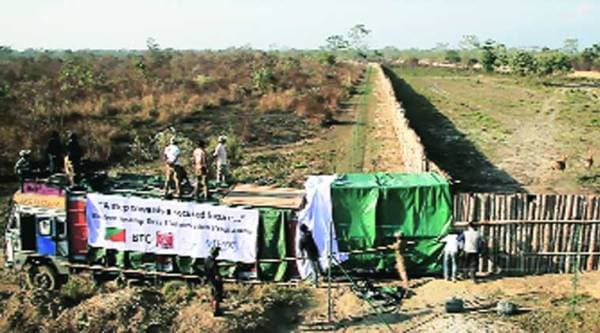- India
- International
19 eastern swamp deer shifted from Kaziranga to Manas
At 854, Eastern swamp deer are far lesser in number than Royal Bengal Tiger or one-horned rhinoceros.
 The deer being released in a special enclosure, ‘boma’, at Manas National Park Saturday. ( Source: WTI)
The deer being released in a special enclosure, ‘boma’, at Manas National Park Saturday. ( Source: WTI)
For the first time in India, eastern swamp deer were shifted from Kaziranga National Park to Manas National Park, both in Assam but about 400 kilometres apart, with the authorities saying translocation was the one way the sub-species, found only in Kaziranga, could be saved from a point of no return.
In the last count held in May this year, it was found that Kaziranga had 854 Eastern swamp deer, including 176 adult males, 504 adult females and 174 calves.
On Saturday, 19 eastern swamp deer (Rucervus duvaucelii ranjitsinhi) — 3 male, 26 female — were brought to Manas National Park by road and released in a specially prepared ‘boma’ secured by a two-line power fence installed over a bamboo barrier, to deter leopards from entering the enclosure. Short grass was earlier transplanted in the ‘boma’ to ensure steady fodder supply to the animals.
Wildlife Trust of India (WTI) officials said the deer will be kept in the special enclosure for the first few months and would be later released in the National Park in batches. Some of them would be kept in the boma for breeding purposes. “Since this would be the source population for Manas National Park, stringent arrangements have been made to ensure their welfare,” a WTI official said.
While the translocation was conducted jointly by the state forest department and WTI in collaboration with ONGC, experts from College of Veterinary Science (AAU) monitored the entire translocation process. Markus Hofmyr, a renowned conservation and animal welfare biologist, was flown in specially from South Africa to help with the capturing of the deer.

A team of experts from WTI and the state forest department will also monitor the deer population to see if the translocation has any adverse impact on them.
Launched in 2010, the three-year long ecological research programme called ‘Eastern Swamp Deer Conservation Project’ intends to understand the ecology of the sub-species and develop management strategies for conservation of their last surviving population in India. Findings on diet, genetic constitution and behaviour have already provided useful insight for scientific management of the deer in Kaziranga, as well as to propel the project into its current second phase of creating a second home for them in Manas National Park, the WTI official said.
Apr 26: Latest News
- 01
- 02
- 03
- 04
- 05







































